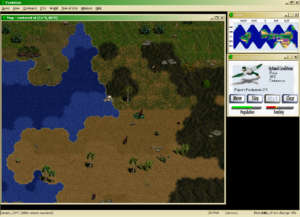Evolution: Conclusions
Somewhat miraculously, I managed to win Evolution without going any farther off schedule. My intelligent species was the Silurians Sleestaks Saurosapiens, which evolved somewhat after their time — I had managed to keep a fairly sizeable and diverse stable of dinosaurs alive after the Cenozoic extinction event, which actually doesn’t seem to be all that unusual for this game, despite the game’s arbitrary penalties on the feeding rate for for creatures that are out of their proper era. (It’s a pretty good system for keeping creatures from developing too far ahead of schedule, because getting a toehold is a struggle for any new species, but an established species that isn’t struggling any more is less affected.) But honestly, I think I could have pulled off a win even if my dinosaurs had gone properly extinct. Evolving a different intelligent species would have taken longer, but I was far enough ahead to take that time.
I think I was more or less primed for victory by my previous game, which was the first time I had actually played a game to completion. Well, not played exactly. Most of the Mesozoic era, and all of the Cenozoic, I zipped through at the maximum time scale. There wasn’t much point in interacting with the game at that point: I had failed to get a mammal population going, and the extinction event left me with nothing but a few stegasauri (more or less a dead end, good for a score bonus at game’s end but only capable of evolving into ankylosaurus and triceratops) and one single low-population dryosaurus unit. A dryosaurus can take you places — it’s a potential ancestor of both Saurosapiens and Psittacisapiens, not to mention all other bird species — but the catastrophe had left these particular dryosauri in a bad state, and they weren’t long for the world. Still, I let the game play out to the end, more or less leaving it alone once I had established triceratops and ankylosaur habitats. The ankylosaurs managed to survive to the very end, even as the virtual player named Darwin filled the world with bats and rabbits and thylacines, finally winning at the 57-million-years-ago mark by developing intelligent wombats.
The main thing I got out of watching that session was an appreciation of the degree of multitasking needed to win. There’s something in the neighborhood of 200 species in the game, which is a drop in the bucket compared to reality, but still far more than it’s easy to manage in your head if you’re in a dominant enough position to have most of them coming to you. (And yes, you do want to develop every species you can, if only to keep them out of the opponent clades.) Being the loser is relatively easy: once you start losing in earnest, you only have to keep track of two or three species at a time.
Nonetheless, it’s a lot easier to keep winning than to start winning. The classic strategy-game positive feedback loop definitely applies here. You might think that the periodic cataclysms and die-offs would put everyone on an even footing, but no. The clade that’s most widespread before the event tends to have the most survivors afterward, and also is in the best position to capitalize on any extinctions.
All in all, I’d say this is actually a pretty good game. Seeing it on a store shelf back in 1997, you’d probably assume that it’s just watered-down educational fare, but there’s some real game here. The main thing I’d change is the UI. The game uses a sort of MDI interface, with various components of the game, including the main view and the various information dialogs, placed in distinct windows with their own title bars, which you can drag around and minimize and so forth (all within a parent window). This may have seemed like a good idea in 1997, when people were still figuring out how to best take advantage of Windows 95, but only one of these sub-windows can have focus at a time, and that’s inconvenient — especially when focus is taken away by a modal pop-up.
 Comments(0)
Comments(0)